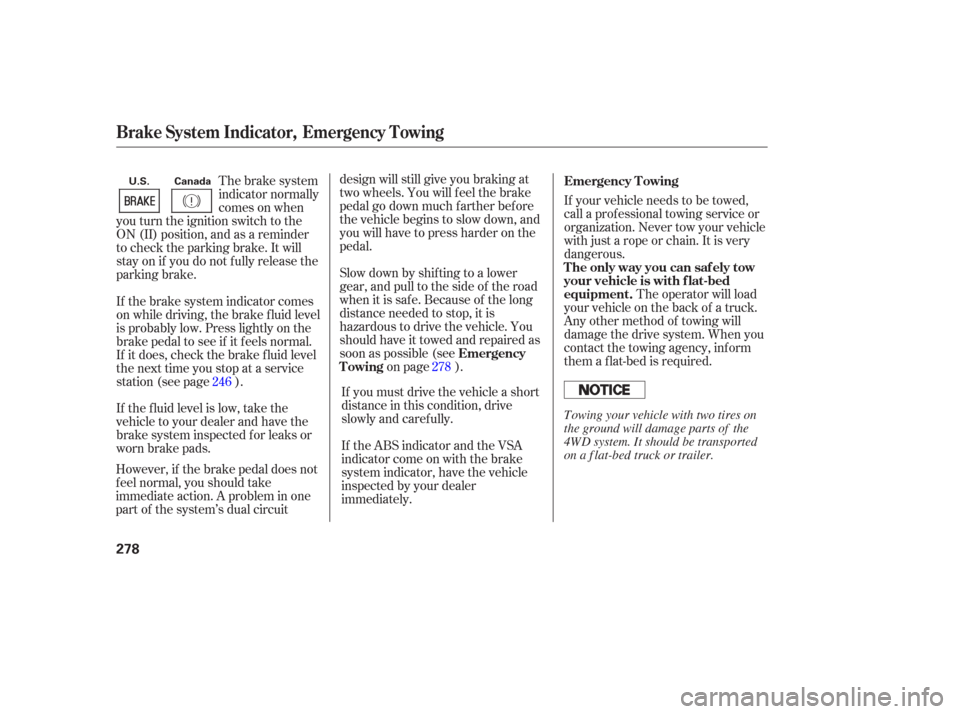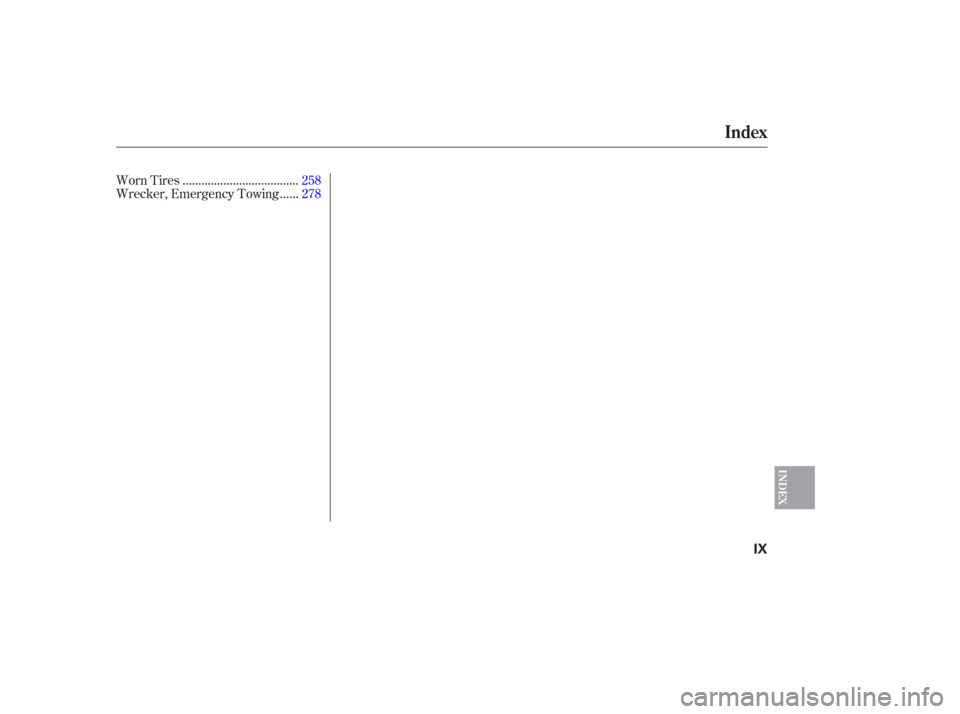2006 HONDA PILOT emergency towing
[x] Cancel search: emergency towingPage 267 of 316

This section covers the more
common problems that motorists
experience with their vehicles. It
gives you inf ormation about how to
safely evaluate the problem and what
to do to correct it. If the problem has
stranded you on the side of the road,
you may be able to get going again.
If not, you will also f ind instructions
on getting your vehicle towed.......................
Compact Spare Tire .266
....................
Changing a Flat Tire .267
.............
If the Engine Won’t Start . 271
................................
Jump Starting .272
..............
If the Engine Overheats . 274
.........
Low Oil Pressure Indicator . 276
..........
Charging System Indicator . 276
..................
Malf unction Indicator . 277
...............
Brake System Indicator . 278
..............................................
Fuses .279
..............................
Fuse Locations .283
Taking Care of the Unexpected
Taking Care of the Unexpected
265
Emergency Towing ....................... 278
Page 277 of 316

If there was no coolant in the
reserve tank, you may need to add
coolant to the radiator. Let the
engine cool down until the pointer
reaches the middle of the tempera-
ture gauge, or lower, bef ore check-
ing the radiator.
Using gloves or a large heavy
cloth, turn the radiator cap
counterclockwise, without pushing
down, to the f irst stop. Af ter the
pressure releases, push down on
the cap, and turn it until it comes
off.Start the engine and set the
temperature control dial to
maximum (climate control to
FULL AUTO at 90°F/32°C). Add
coolant to the radiator up to the
base of the f iller neck. If you do
not have the proper coolant
mixture available, you can add
plain water. Remember to have
the cooling system drained and
ref illed with the proper mixture as
soon as you can.
Put the radiator cap back on
tightly. Run the engine, and watch
the temperature gauge. If it goes
back to the red mark, the engine
needs repair (see
If the temperature stays normal,
check the coolant level in the
radiator reserve tank. If it has
gone down, add coolant to the
MAX mark. Put the cap back on
tightly.
7.
8.
9.
10.
11. Emergency
If the Engine Overheats
Taking Care of the Unexpected
275
Removing the radiator cap
while the engine is hot can
cause the coolant to spray out,
seriously scalding you.
Always let the engine and
radiator cool down before
removing the radiator cap.
Towingon page278).
Page 280 of 316

If you must drive the vehicle a short
distance in this condition, drive
slowly and caref ully.
If the ABS indicator and the VSA
indicator come on with the brake
system indicator, have the vehicle
inspected by your dealer
immediately.
design will still give you braking at
two wheels. You will f eel the brake
pedal go down much f arther bef ore
the vehicle begins to slow down, and
you will have to press harder on the
pedal.
Slow down by shif ting to a lower
gear, and pull to the side of the road
when it is saf e. Because of the long
distance needed to stop, it is
hazardous to drive the vehicle. You
should have it towed and repaired as
soon as possible (see
The brake system
indicator normally
comes on when
you turn the ignition switch to the
ON (II) position, and as a reminder
to check the parking brake. It will
stay on if you do not f ully release the
parking brake.
If the f luid level is low, take the
vehicle to your dealer and have the
brake system inspected f or leaks or
worn brake pads. If the brake system indicator comes
on while driving, the brake f luid level
is probably low. Press lightly on the
brake pedal to see if it f eels normal.
If it does, check the brake f luid level
the next time you stop at a service
station (see page ). 246 Emergency
T owing
278
U.S. Canada
Brake System IndicatorEmergency Towing
,
However, if the brake pedal does not
f eel normal, you should take
immediate action. A problem in one
part of the system’s dual circuit on page
278).
Emergency T owing
If your vehicle needs to be towed,
call a prof essional towing service or
organization. Never tow your vehicle
with just a rope or chain. It is very
dangerous.
Any other method of towing will
damage the drive system. When you
contact the towing agency, inf orm
them a f lat-bed is required. The operator will load
your vehicle on the back of a truck. The only way you can saf ely tow
your vehicle is with f lat-bed
equipment.
Towing your vehicle with two tires on
the ground will damage parts of the
4WD system. It s hould be transported
on a f lat-bed truck or trailer.
Page 281 of 316

The vehicle’s f uses are located in
f our f use boxes. The interior f use
boxes are located under the
dashboard on the driver’s and
passenger’s side.
CONT INUED
Emergency Towing, Fuses
Taking Care of the Unexpected
279
DRIVER’ S SIDE INTERIOR
If , due to damage, your vehicle must
be towed with all f our wheels on the
ground, do the f ollowing:With all f our wheels on the ground,
it is best to tow the vehicle no farther
than 50 miles (80 km), and keep the
speed below 35 mph (55 km/h).
Release the parking brake.
Start the engine.
Shif t to D f or several seconds,
then to N.
Turn of f the engine.
Improper towing preparation will
damage the transmission. Follow the
above procedure exactly. If you cannot
shif t the transmission or start the
engine, your vehicle must be
transported with the all f our wheels of f
the ground. The steerin
g system can be damaged if
the steering wheel is locked. Leave the
ignition switch in the ACCESSORY (I)
position, and make sure the steering
wheel turns f reely bef ore you begin
towing.
Trying to lif t or tow your vehicle by the
bumpers will cause serious damage.
The bumpers are not designed to
support the vehicle’s weight. Fuses
Page 308 of 316

........................
Certif ication Label .286
............................................
Chains .261
....................
Changing a Flat Tire .267
Change Oil ........................................
How to .240
......................................
When to .229
...
Charging System Indicator . 62,276
............
Checklist, Bef ore Driving . 198
..................
Childproof Door Locks . 83
Child Seats .........................................
LATCH .47
..........
Tether Anchorage Points . 51
...............
Climate Control System . 112
.........................
Clock, Setting the .140
.....................
Code, Audio System .139
........................
CO in the Exhaust .293
............
Cold Weather, Starting in . 199
......................
Compact Spare Tire .266
...................
Console Compartment . 99
.................
Consumer Inf ormation . 300
.............
Controls, Instruments and . 59
Coolant ........................................
Adding .242
....................................
Checking .189
.........................
Proper Solution .242
...................
Temperature Gauge . 71...................
Conversation Mirror .100
Crankcase Emissions Control ........................................
System .293
............
Cruise Control Operation . 175
....
Customer Service Inf ormation . 300
................
DANGER, Explanation of . ii
...................................
Dashboard .4, 60
................
Daytime Running Lights . 76
Daytime Running Lights .......................................
Indicator .67
.................................
Dead Battery .272
............
Def ects, Reporting Saf ety . 302
................
Def ogger, Rear Window . 77
......
Def rosting the Windows . 108,110
....................................
Dimensions .288
...............
Dimming the Headlights . 75
Dipstick ..........
Automatic Transmission . 244
..................................
Engine Oil .189
....................
Directional Signals . 66,75
........
Disc Brake Wear Indicators . 210
.....................
Disposal of Used Oil .241 Doors
..............
Locking and Unlocking . 82
..........
DOT Tire Quality Grading . 290
...........
Driver and Passenger Safety . 7
...........................................
Driving .197
....................................
Economy .190
...................................
DVD Player .142
........
DVD Player Error Message . 171
..............................
Economy, Fuel .190
............
Emergencies on the Road . 265
.............
Battery, Jump Starting . 272
...........
Brake System Indicator . 278
................
Changing a Flat Tire . 267
.....
Charging System Indicator . 276
..................
Checking the Fuses . 279
.....
Low Oil Pressure Indicator . 276
...
Malf unction Indicator Lamp . 277
..................
Overheated Engine . 274
...........................
Emergency Brake .97
......................
Emergency Flashers .77
.......................
Emissions Controls .293
.............
Emissions Testing, State . 296
Index
D
E
II
Emergency Towing .......................278
Page 314 of 316

...............................................
Tires .257
..............................
Air Pressure .257
.........................
Checking Wear .258
..........................
Compact Spare .266
......
DOT Tire Quality Grading . 290
......................................
Inf lation .257
..................................
Inspection .258
..............................
Maintenance .259
...................................
Replacing .260
......................................
Rotating .259
...........................................
Snow .260
............................
Specif ications .289
...................
Tools, Tire Changing . 267
Towing .....................................
A Trailer .213
....
Equipment and Accessories . 219
.......................
Traction Devices .261
.............................
Weight Limit .215
......................
Trailer Driving Tips .220
Transmission ...............
Checking Fluid Level . 244
...........................
Fluid Selection .244
..............
Identif ication Number . 286
.............
Shif ting the Automatic . 200.....................................
Treadwear .290
.......................................
Trip Meter .70
....................................
Turn Signals .75
Unexpected, Taking Care ..........................................
of the .265
....
Unif orm Tire Quality Grading . 290
........................
Unleaded Gasoline .186
.......
Used Oil, How to Dispose of . 241
................................
Vanity Mirror .101
.................
Vehicle Capacity Load . 194
......................
Vehicle Dimensions .288
....
Vehicle Identif ication Number . 286
Vehicle Stability Assist (VSA) ....................................
System .211
.........................
VSA Of f Switch .212
.............................
Vehicle Storage .263
.................................................
VIN .286
..................................
Viscosity, Oil .239
..................................
VTM-4 Lock .204 .............
WARNING, Explanation of . ii
.........
Warning Labels, Location of . 58
....................
Warranty Coverages .301
Washer, Windshield ........
Checking the Fluid Level . 243
............................
Level Indicator .67
.....................................
Operation .74
Wheels ...............
Adjusting the Steering . 78
............
Alignment and Balance . 259
..........................
Compact Spare .266
...............................
Nut Wrench .269
Windows ..................
Operating the Power . 94
...........................
Rear, Def ogger .77
Windshield ...........................
Def roster .108, 110
.......................................
Washers .74
Wipers, Windshield .......................
Changing Blades .255
.....................................
Operation .74
Rear Window Wiper and .....................................
Washer .74
..................
Wireless Headphones . 172
Index
U
V W
VIII
Emergency Wrecker ................
.278
Page 315 of 316

....................................
Worn Tires .258
Index
INDEX
IX
Wrecker, Emergency Towing...... 278